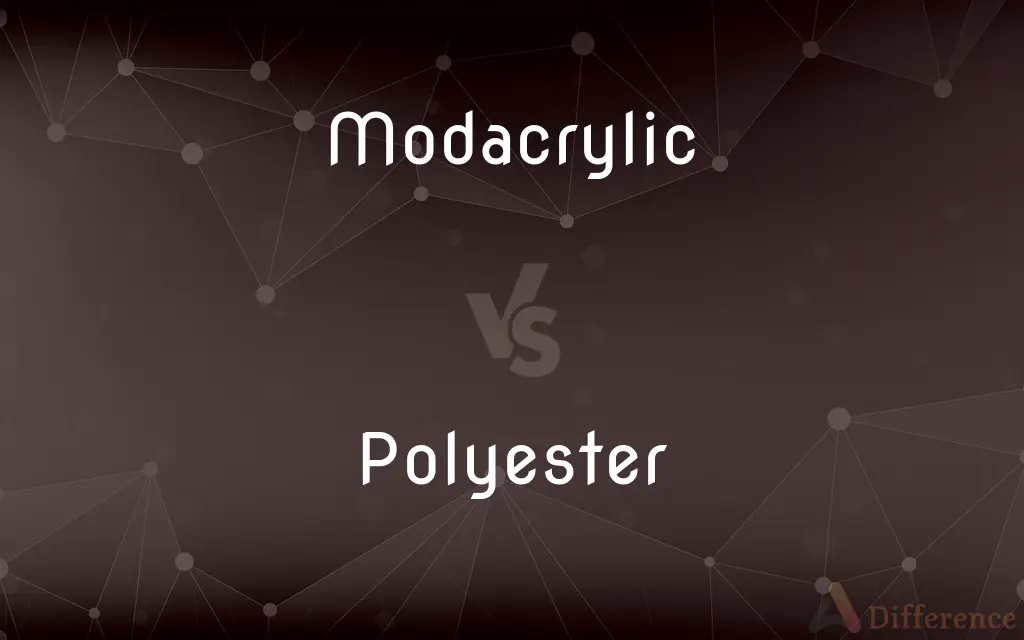Modacrylic vs. Polyester — What's the Difference?
Edited by Tayyaba Rehman — By Urooj Arif — Updated on April 14, 2024
Modacrylic fibers are known for their flame resistance and softness, ideal for safety applications, while polyester fibers are durable, quick-drying, and widely used in everyday and performance wear.

Difference Between Modacrylic and Polyester
Table of Contents
ADVERTISEMENT
Key Differences
Modacrylic fibers are synthetic copolymers primarily valued for their high flame resistance, which makes them a top choice for protective clothing and hairpieces. Polyester, on the other hand, is renowned for its strength, durability, and resistance to shrinking and stretching, making it a staple in both casual and performance textiles.
The texture of modacrylic fabric tends to be softer and more flexible, which is why it is often used in faux furs and wigs. Polyester fibers, whereas, are generally stiffer and more suitable for heavy-duty applications like backpacks and curtains, as well as clothing.
Modacrylics are engineered to be non-allergenic and resistant to chemicals and solvents, enhancing their use in industrial environments. Conversely, polyester is also chemical resistant but is less specialized, focusing more on general utility in textiles.
From an environmental standpoint, both fibers are synthetic but modacrylics often require more specialized treatments to achieve their properties, potentially impacting their environmental footprint. Polyester is criticized for environmental concerns, particularly microfiber pollution, but is more commonly recycled.
In terms of care, modacrylic garments require delicate handling, usually needing cool washes and avoidance of heat. Polyester garments are easier to care for, with most being machine washable and dryable at higher temperatures without significant degradation.
ADVERTISEMENT
Comparison Chart
Primary Use
Protective clothing, faux fur, wigs
Clothing, furnishings, industrial uses
Flame Resistance
High flame resistance
Less flame resistant
Texture
Soft and flexible
Stiffer and more durable
Chemical Resistance
High, non-allergenic
High, but less specialized
Environmental Impact
Higher due to specialized treatments
High, mainly due to microfiber pollution
Compare with Definitions
Modacrylic
A synthetic fiber known for flame resistance.
Firefighters' uniforms often use modacrylic fabric for safety.
Polyester
Can be recycled.
Recycled polyester is increasingly used in eco-conscious fashion.
Modacrylic
Commonly used in faux fur production.
Many luxury faux fur coats are made from modacrylic due to its soft texture.
Polyester
A highly durable synthetic fiber.
Polyester is used in making durable hiking backpacks.
Modacrylic
Non-allergenic material.
Modacrylic wigs are preferred by those with sensitive scalps.
Polyester
Widely used in clothing.
Most sportswear utilizes polyester for its sweat-wicking properties.
Modacrylic
Resistant to chemicals and solvents.
Modacrylic gloves are used in chemical industries to protect hands.
Polyester
Prone to static and pilling.
Older polyester garments may show pilling from wear and friction.
Modacrylic
Requires careful laundering.
Modacrylic clothing should not be washed with hot water to avoid melting.
Polyester
Resists shrinking and stretching.
Polyester curtains maintain their shape and size even after washing.
Modacrylic
A modacrylic is a synthetic copolymer. Modacrylics are soft, strong, resilient and dimensionally stable.
Polyester
Polyester is a category of polymers that contain the ester functional group in every repeat unit of their main chain. As a specific material, it most commonly refers to a type called polyethylene terephthalate (PET).
Modacrylic
One of several synthetic, long-chain polymer textile fibers containing 35-85 percent acrylonitrile.
Polyester
A synthetic resin in which the polymer units are linked by ester groups, used chiefly to make synthetic textile fibres.
Modacrylic
Any of several copolymer fibres (mostly polymers of acrylonitrile) that are soft yet strong, and are used in carpeting, wigs, etc.
Polyester
Any of numerous synthetic polymers produced chiefly by reaction of dicarboxylic acids with dihydric alcohols and used primarily as light, strong, weather-resistant resins in boat hulls, textile fibers, adhesives, and molded parts.
Polyester
A wrinkle-resistant fabric of fibers made from any of these resins.
Polyester
Any polymer whose monomers are linked together by ester bonds
Polyester
A material or fabric made from polyester polymer
Polyester
Of, or consisting of polyesters
Polyester
Any of numerous synthetic resins; they are light and strong and weather resistant
Polyester
A complex ester used for making fibers or resins or plastics or as a plasticizer
Polyester
Any of a large class of synthetic fabrics
Common Curiosities
Why is polyester preferred for outdoor garments?
Its durability and moisture-wicking properties make it ideal for outdoor and performance wear.
How are modacrylic and polyester different?
The main differences lie in their uses and properties; modacrylic is flame retardant and softer, while polyester is more versatile and durable.
Can modacrylic be used for everyday clothing?
While possible, modacrylic is less common in everyday wear due to its specific properties and cost.
What is polyester?
Polyester is a synthetic fabric known for its durability, resistance to chemicals, and ease of maintenance.
How does the cost of modacrylic compare to polyester?
Modacrylic typically costs more due to its specialized properties and production processes.
What is modacrylic?
Modacrylic is a type of synthetic copolymer mainly used for its flame retardant properties.
Is polyester good for the environment?
Polyester has environmental drawbacks, particularly concerning microfiber pollution.
Which fabric is more environmentally friendly?
Both have environmental impacts, but polyester has more established recycling paths.
What are typical uses of modacrylic?
It is typically used in safety apparel, wigs, and faux fur products.
Which is more heat resistant, modacrylic or polyester?
Modacrylic is more heat resistant, making it suitable for safety gear.
Are both modacrylic and polyester recyclable?
Polyester is commonly recycled, but modacrylic is less frequently recycled due to its niche applications.
Can I iron modacrylic and polyester garments?
Modacrylic should not be ironed due to its low melting point; polyester can be ironed at low temperatures.
What care is required for modacrylic fabrics?
Modacrylic fabrics require gentle care, avoiding high temperatures in washing and drying.
Are there any common products made from both materials?
Both materials are used in various textiles, but modacrylic is specifically favored in protective and specialty fabrics.
What is the future of synthetic fibers like modacrylic and polyester?
Innovations focus on enhancing environmental sustainability and performance features.
Share Your Discovery

Previous Comparison
Merger vs. Acquisition
Next Comparison
Elegant vs. BeautifulAuthor Spotlight
Written by
Urooj ArifUrooj is a skilled content writer at Ask Difference, known for her exceptional ability to simplify complex topics into engaging and informative content. With a passion for research and a flair for clear, concise writing, she consistently delivers articles that resonate with our diverse audience.
Edited by
Tayyaba RehmanTayyaba Rehman is a distinguished writer, currently serving as a primary contributor to askdifference.com. As a researcher in semantics and etymology, Tayyaba's passion for the complexity of languages and their distinctions has found a perfect home on the platform. Tayyaba delves into the intricacies of language, distinguishing between commonly confused words and phrases, thereby providing clarity for readers worldwide.
















































